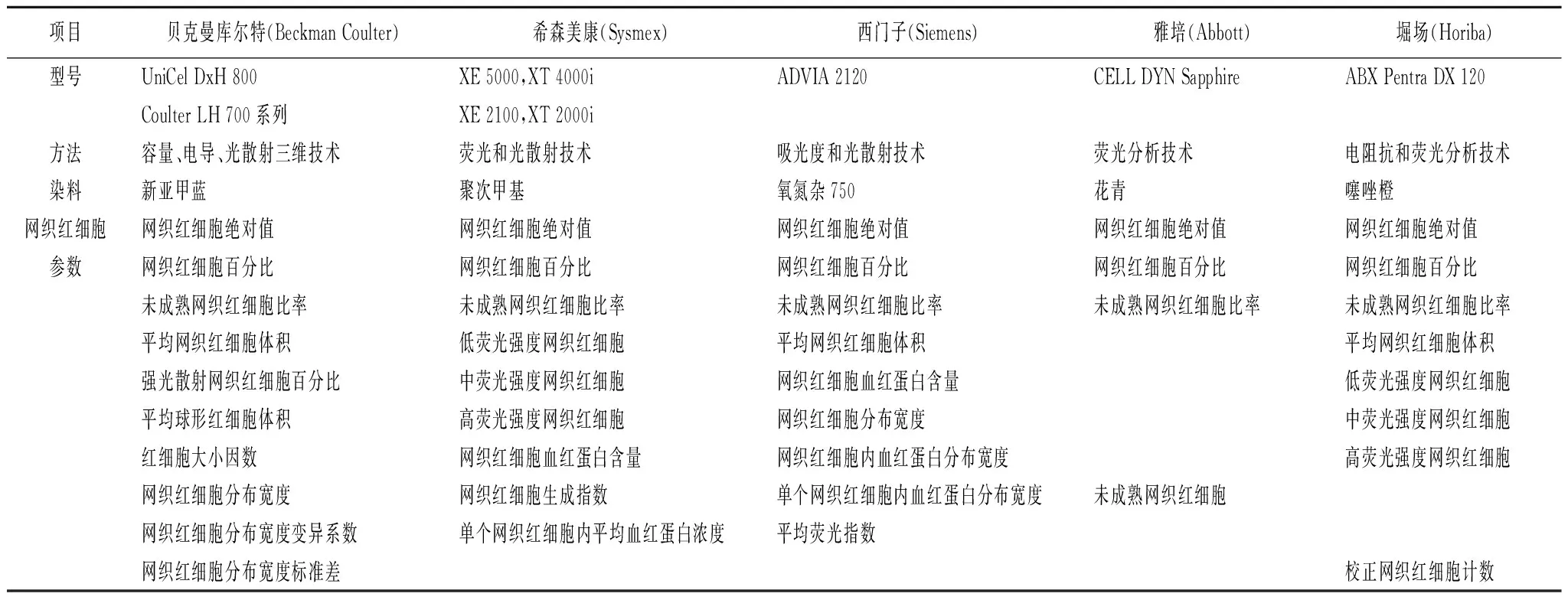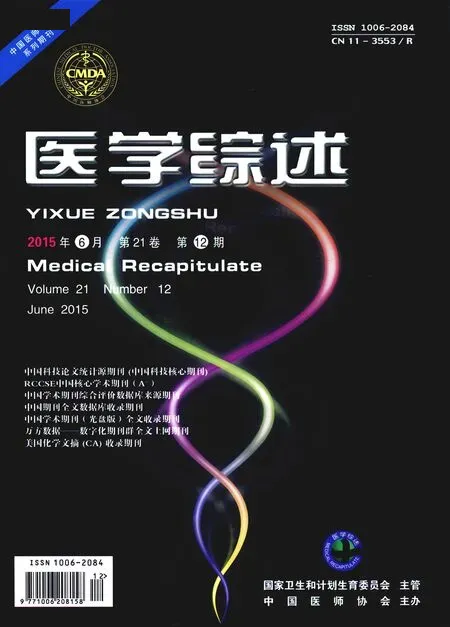网织红细胞分析技术与临床应用
徐玉婵(综述),林发全(审校)
(1.柳州市柳铁中心医院检验科,广西 柳州 545007; 2.广西医科大学第一附属医院检验科,南宁 530021)
网织红细胞分析技术与临床应用
徐玉婵1△(综述),林发全2※(审校)
(1.柳州市柳铁中心医院检验科,广西 柳州 545007; 2.广西医科大学第一附属医院检验科,南宁 530021)
网织红细胞是介于晚幼红细胞与成熟红细胞之间的尚未完全成熟的红细胞,是红细胞成熟过程中的一个重要阶段,对血液疾病的诊断和治疗有重要意义。自20世纪90年代中期以来,网织红细胞检测技术有了很大进展,可为临床提供更精确更多的检测参数。相信随着网织红细胞检测的标准化进程及循证医学的发展,网织红细胞检测在血液疾病的诊断中会发挥日益重要的作用。
网织红细胞;网织红细胞参数;临床应用
网织红细胞是尚未成熟的红细胞,其胞质中尚残存部分嗜碱性物质(RNA)经煌焦油蓝染色呈深染的网状结构,故名网织红细胞。它反映骨髓造血功能,对一些疾病的诊断和治疗有重要意义。传统的网织红细胞分析技术为人工染色镜检,操作繁琐费时,稳定性和重复性不理想,自动化仪器网织红细胞计数准确度高,检测参数多,临床应用也更加广泛。现对网织红细胞分析技术与临床应用进行综述。
1 网织红细胞分析技术
1865年,有学者在贫血患者的血涂片中发现红细胞中的特殊颗粒,并将它描述为从有核状态到成熟前的过渡期红细胞[1]。之后Erhich用亚甲蓝对血涂片进行染色,发现这种红细胞呈现出网状结构,因而将之命名为网织红细胞,并且建立了传统的网织红细胞活体染色和显微镜检测法[2]。后来虽然有米勒窥盘法等改良方法,但仍然无法避免人工方法受主观因素影响较大、准确性较差的局限。Tanke等[3]在1983年首先将流式细胞仪应用到网织红细胞分析上,开始了网织红细胞检测技术由人工计数到自动化仪器分析时代的跨越。1988年,日本希森美康(Sysmex)公司推出世界首台专门用于网织红细胞检测的全自动网织红细胞计数仪Sysmex R-1000[4],该公司后来改进推出的Sysmex R-3000 至今仍然是美国食品药品管理局认可的网织红细胞分析准确性的对照标准。1993年美国拜尔公司(Bayer)推出Technicon H3型可同时进行网织红细胞计数的多功能自动血液分析仪[2]。Brugnara等[5]将Technicon H3和Sysmex R-3000及流式细胞仪进行了比较,发现这种多功能自动血液分析仪在网织红细胞检测上同样具有良好的精密度和线性范围,但是测试成本却只有Sysmex R-3000的一半。这种快捷、低成本的优势使多功能自动血液分析仪更能满足市场的需求,从而更容易推广应用。但是,各厂家采用的检测技术和荧光染料不同,所获得的网织红细胞参数也有所差异。主要的多功能自动血液分析仪的型号,方法,染料,可检测的网织红细胞参数见表1[1]。
2 主要网织红细胞参数的临床应用
2.1 未成熟网织红细胞比率(immature reticulocyte fraction,IRF) 利用IRF结合网织红细胞百分比(reticulocyte count,Ret%)可以区分贫血的类型[6]。以骨髓红细胞生成增加为特点的急性贫血如溶血性或失血性贫血,总网织红细胞计数和IRF增加;骨髓红细胞生成减少的慢性肾病性贫血,两个值均降低;骨髓增生异常综合征和急性感染中,总网织红细胞计数减少或正常,而IRF增加。
Yesmin等[7]研究表明,IRF是骨髓造血功能恢复的早期指标。造血干细胞移植是治疗恶性血液病患者的首选。对移植后造血功能恢复的监测有利于病情观察及制订治疗方案,是判定移植是否成功的依据。目前临床上大多采用Ret%,中性粒细胞绝对计数(absolute neutrophil count, ANC)和血小板计数(platelet count,PLT)监测骨髓移植后造血反应,但网织红细胞从骨髓释放入外周血过程中影响因素较多,且当在临床感染或受到移植排斥反应等影响时,能引起ANC抑制。Goncalo等[8]发现,IRF和未成熟网织血小板比率在骨髓移植后造血功能恢复的天数(中位数)均显著早于ANC 和PLT,IRF为11 d,未成熟网织血小板比率为10 d而ANC为15 d,PLT为12 d。

表1 主要的多功能自动血液分析仪一般信息及网织红细胞参数
IRF还可用来预测外周血干细胞收集时间。造血干细胞移植成活所需的细胞数量要求CD34+细胞>2×106/kg。在人体稳态情况下,外周血干细胞数量少,需要通过大剂量化疗或应用生长因子进行造血干细胞动员来提高外周血干细胞数量。干细胞收集时间是决定采集质量的关键。以传统的WBC>1×109/ L作为采集时间,约有15%受试者采集到的CD34+细胞数量不符合要求。研究表明,单核细胞计数≥1.455×109/L为外周血干细胞采集的最佳时机,而IRF是一个有价值的负面预测指标,当IRF≤0.2可认为不适合采集[9-10]。
2.2 网织红细胞生成指数(reticulocyte production index,RPI) 网织红细胞在外周血中的生存期一般为1 d,贫血患者分泌促红细胞生成素(erythropoietin,EPO)促进Ⅳ型以前更幼稚的网织红细胞提前释放,使其生存期延长到2~2.5 d,引起网织红细胞绝对值(reticulocyte absolute count,Ret#)、Ret%假性升高。RPI又叫校正网织红细胞计数,代表网织红细胞的生成相当于正常人的多少倍,可以根据患者贫血程度纠正这种因网织红细胞提前释放引起的计算误差[11]。正常人RPI=1.0,意义为正常人维持100%的有效制造红细胞的能力。RPI可以根据骨髓红系的造血能力对贫血的类型进行鉴别诊断。重度再生障碍性贫血骨髓红系无效造血,RPI极度降低;溶血性贫血患者骨髓红系代偿性增生,RPI显著升高。重度再生障碍性贫血的诊断标准自1976年由Camitta提出以来就一直沿用至今(以下至少符合2项):ANC<0.5×109/L;PLT<20×109/ L;校正网织红细胞计数<1%[12]。EPO的临床应用可以减少输血,部分改善贫血症状,血清EPO水平与外周血Ret、RPI数值密切相关。Donato等[13]研究了50例用EPO治疗的新生儿溶血疾病患儿,开始用EPO治疗时患儿血细胞比容(hematocrit,HCT)为(24.1±2.8)%,RPI为(0.34±0.25),在治疗后第7日和第14日 HCT和RPI显著升高。

静脉注射铁化合物常用于治疗铁缺乏的透析患者。CHr和平均网织红细胞体积(mean reticulocyte volume,MRV)可以监测静脉铁治疗后的早期反应,48 h后这两个指标显著升高,而在中断治疗后又突然减少[17]。1989年以来重组人红细胞生成素一直用于治疗慢性肾病和癌症相关贫血患者[14],由于红细胞加速生成铁储存不足而导致功能性缺铁,因而监测使用重组人红细胞生成素治疗患者的铁状态是非常重要的。2004年的欧洲慢性肾病贫血患者管理指南建议用CHr、HYPO%、 转铁蛋白饱和度这3个指标来监测缺铁性红细胞生成[18]。

2.5 平均球形红细胞体积(mean sphered corpuscular volume,MSCV) 新亚甲蓝染色的红细胞经一种酸性、低渗的溶液处理后形成脱蛋白的球形红细胞。容量、电导、光散射技术将球形红细胞分成成熟红细胞和网织红细胞。所有红细胞(包括成熟红细胞和网织红细胞)的平均体积为MSCV。正常人MSCV大于MCV。MSCV可用于遗传性球形红细胞增多症(hereditary spherocytosis,HS)的辅助诊断和大细胞性贫血的鉴别诊断。传统的HS筛查实验敏感性和特异性并不理想,再加上部分HS患者临床症状不典型,诊断上极易漏诊、误诊。1999年Chiron等[22]首先使用MSCV 多功能自动血液分析仪的出现使网织红细胞检测变得更加准确、快捷和经济。利用电阻抗和荧光分析技术等对网织红细胞的数量、体积、成熟程度、血红蛋白水平进行检测,可得到多种网织红细胞参数,可应用于贫血的诊断、疗效观察、早期识别骨髓造血功能的恢复以及预测外周血干细胞采集时间等。一些网织红细胞参数如CHr、RSF对于缺铁性贫血,MSCV对于HS的诊断具有较好的敏感性和特异性,与传统的侵入性骨髓细胞学检查相比具有一定的优势。 [1] Piva E,Brugnara C,Chiandetti L,etal.Automated reticulocyte counting:state of the art and clinical applications in the evaluation of erythropoiesis[J].Clin Chem Lab Med,2010,48(10):1369-1380. [2] 张时民,李晓京.网织红细胞检测技术的进展和临床应用[J].中国医疗器械信息,2007,13(6):15-23. [3] Tanke HJ,Rothbarth PH,Vossen JM,etal.Flow cytometry of reticulocytes applied to clinical hematology[J].Blood,1983,61(6):1091-1097. [4] Tichelli A,Gratwohl A,Driessen A,etal.Evaluation of the Sysmex R-1000.An automated reticulocyte analyzer[J].Am J Clin Pathol,1990,93(1):70-78. [5] Brugnara C,Hipp MJ,Irving PJ,etal.Automated reticulocyte counting and measurement of reticulocyte cellular indices.Evaluation of the Miles H*3 blood analyzer[J].Am J Clin Pathol,1994,102(5):623-632. [6] Buttarello M,Plebani M.Automated blood cell counts:state of the art[J].Am J Clin Pathol,2008,130(1):104-116. [7] Yesmin S,Sultana T,Roy CK,etal.Immature reticulocyte fraction as a predictor of bone marrow recovery in children with acute lymphoblastic leukaemia on remission induction phase[J].Bangladesh Med Res Counc Bull,2011,37(2):57-60. [8] Goncalo AP,Barbosa IL,Campilho F,etal.Predictive value of immature reticulocyte and platelet fractions in hematopoietic recovery of allograft patients[J].Transplant Proc,2011,43(1):241-243. [9] Yang SM,Chen H,Chen YH,etal.Dynamics of monocyte count:a good predictor for timing of peripheral blood stem cellcollection[J].J Clin Apher,2012,27(4):193-199. [10] Dunlop LC,Cohen J,Harvey M,etal.The immature reticulocyte fraction:a negative predictor of the harvesting of CD34 cells for autologous peripheral blood stem cell transplantation[J].Clin Lab Haematol,2006,28(4):245-247. [11] Heimpel H,Diem H,Nebe T.Counting reticulocytes:new importance of an old method [J].Med Klin (Munich),2010,105(8):538-543. [12] Yoon HH,Huh SJ,Lee JH,etal.Should we still use Camitta′s criteria for severe aplastic anemia? [J].Korean J Hematol,2012,47(2):126-130. [13] Donato H,Bacciedoni V,García C,etal.Recombinant erythropoietin as treatment for hyporegenerative anemia following hemolytic disease of the newborn[J].Arch Argent Pediatr,2009,107(2):119-125. [14] Urrechaga E,Borque L,Escanero JF.Biomarkers of hypochromia:the contemporary assessment of iron status and erythropoiesis[J].Biomed Res Int,2013,2013:603786. [15] Goodnough LT,Nemeth E,Ganz T.Detection,evaluation,and management of iron-restricted erythropoiesis[J].Blood,2010,116(23):4754-4761. [16] Karagülle M,Gündüz E,Sahin Mutlu F,etal.Clinical significance of reticulocyte hemoglobin content in the diagnosis of iron defici-ency anemia[J].Turk J Haematol,2013,30(2):153-156. [17] Buttarello M,Temporin V,Ceravolo R,etal.The new reticulocyte parameter (Ret-Y) of the Sysmex XE 2100:its use in the diagnosis and monitoring of posttreatment sideropenic anemia[J].Am J Clin Pathol,2004,121(4):489-495. [18] Locatelli F,Aljama P,Bárány P,etal.Revised European best practice guidelines for the management of anaemia in patients with chronic renal failure[J].Nephrol Dial Transplant,2004,19(2):1-47. [19] Parisotto R,Wu M,Ashenden MJ,etal.Detection of recombinant human erythropoietin abuse in athletes utilizing markers of altered erythropoiesis[J].Haematologica,2001,86(2):128-137. [20] Noronha JF,de Souza CA,Vigorito AC,etal.Immature reticulocytes as an early predictor of engraftment in autologous and allogeneic bone marrow transplantation[J].Clin Lab Haematol,2003,25(1):47-54. [21] Oustamanolakis P,Koutroubakis IE,Kouroumalis EA,etal.Diagnosing anemia in inflammatory bowel disease:beyond the established markers[J].J Crohns Colitis,2011,5(5):381-391. [22] Chiron M,Cynober T,Mielot F,etal.The GEN.S:a fortuitous finding of a routine screening test for hereditary spherocytosis[J].Hematol Cell Ther,1999,41(3):113-116. [23] Broséus J,Visomblain B,Guy J,etal.Evaluation of mean sphered corpuscular volume for predicting hereditary spherocytosis[J].Int J Lab Hematol,2010,32(5):519-523. [24] Liao L,Deng ZF,Qiu YL,etal.Values of mean cell volume and mean sphered cell volume can differentiate hereditary spherocytosis and thalassemia[J].Hematology,2014,19(7):393-396. [25] Kim MH.Clinical significance of reticulocyte maturation parameters in the differential diagnosis macrocytic anemias[J].Korean J Lab Med,2007,27(1):13-18. Study on Reticulocyte Analysis Techniques and Its Clinical Application XUYu-chan1,LINFa-quan2. (1.DepartmentofClinicalLaboratory,LiuzhouMunicipalLiutieCentralHospital,Liuzhou545007,China; 2.DepartmentofClinicalLaboratory,theFirstAffiliatedHospitalofGuangxiMedicalUniversity,Nanning530021,China) Reticulocytes refer to the red blood cells not fully mature between metarubricyte and mature red blood cells.It is an important stage in the mature process of red blood cells.Reticulocyte plays an important role in the diagnosis and treatment of blood diseases.Since the mid 1990s,the rapid development of reticulocyte detection technology in clinical provides more precise reticulocyte count and more valuable reticulocyte parameters.Here is to make a review of the advances in reticulocyte analysis technology and the clinical application of main reticulocyte parameters.It is believed that with standardization of reticulocyte detection and verification of evidence-based medicine,reticulocyte analysis technology is expected to play an increasingly important role in the diagnosis of some blood diseases. Reticulocyte; Reticulocyte parameters; Clinical application R446.11 A 1006-2084(2015)12-2231-03 10.3969/j.issn.1006-2084.2015.12.044 2014-06-09 2014-10-16 编辑:相丹峰3 结 语

